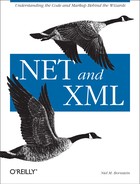Populating a DataSet
The
DataSet is now ready to use just as if you had
created it procedurally. You can create new rows in each of its
tables, using the DataTable.NewRow( ) and
DataTable.Rows.Add( ) methods, as shown in Example 11-5.
using System;
using System.Data;
public class CreateData {
public static void Main(string [ ] args) {
DataSet dataSet = new DataSet( );
dataSet.ReadXmlSchema("Coupons.xsd");
DataTable couponsTable = dataSet.Tables["coupons"];
DataRow couponRow = couponsTable.NewRow( );
couponRow["coupon_code"] = "763FF";
couponRow["discount_amount"] = 0.5;
couponRow["discount_type"] = DiscountType.Fixed;
couponRow["expiration_date"] = new DateTime(2002,12,31);
couponsTable.Rows.Add(couponRow);
dataSet.WriteXml("Coupons.xml");
}
}Some important highlights of this program are listed below. First, a
new DataSet instance is created, and its structure
is populated with the saved Coupons.xsd schema:
DataSet dataSet = new DataSet( );
dataSet.ReadXmlSchema("Coupons.xsd");Next, the “coupons” table is
retrieved using the
DataTableCollection’s string
indexer:
DataTable couponsTable = dataSet.Tables["coupons"];
You
can only create a new row using the
DataTable’s NewRow(
) factory method. This is because the columns must be
populated according to the database schema stored in the
DataTable. Note that the NewRow(
) method does not actually add the new
DataRow to the DataTable; that
happens later:
DataRow couponRow = couponsTable.NewRow( );
Now you can access each column from the new
DataRow and set its value:
couponRow["coupon_code"] = "763FF"; couponRow["discount_amount"] = 0.5; couponRow["discount_type"] = DiscountType.Fixed; couponRow["expiration_date"] = new DateTime(2002,12,31);
Now that
the DataRow is fully populated with data,
it’s time to add it to the
DataTable’s
DataRowCollection. If some constraint or relation
was not satisfied at this point, a specific
DataException is thrown, giving details as to what
constraint or relation was violated:
couponsTable.Rows.Add(couponRow);
Finally, the last line writes the entire DataSet
to an XML file:
dataSet.WriteXml("Coupons.xml");The Coupons.xml file generated by
the last line is shown in Example 11-6. You can see
that it’s a normal XML file, and it is valid
according to the schema in Coupons.xsd.
<?xml version="1.0" standalone="yes"?>
<AngusHardware>
<coupons>
<coupon_code>763FF</coupon_code>
<discount_amount>0.5</discount_amount>
<discount_type>1</discount_type>
<expiration_date>2002-12-31T00:00:00.0000000-05:00</expiration_date>
</coupons>
</AngusHardware>
Remember,
you can always verify that any XML file is valid according to a DTD
or XML Schema with the XmlValidatingReader:
XmlSchema schema = XmlSchema.Read(
new FileStream("Coupons.xsd", FileMode.Open), null);
XmlValidatingReader reader = new XmlValidatingReader(
new XmlTextReader("Coupons.xml"));
reader.Schemas.Add(schema);
reader.ValidationType = ValidationType.Schema;
while (reader.Read( )) {
// this will throw an exception if invalid
}
You can also create an XML file that
contains both the schema to define the DataSet
structure and the data to populate it. The DataSet.WriteXml(
) method takes an additional optional parameter, an
XmlWriteMode enumeration instance. The following
list shows its values and what effect they have:
-
DiffGram The output file contains a
DiffGram, which is an XML format that specifies the differences between aDataSetin memory and the underlying database. I’ll talk more about theDiffGramlater:<?xml version="1.0" standalone="yes"?> <diffgr:diffgram xmlns:msdata="urn:schemas-microsoft-com:xml-msdata" xmlns:diffgr="urn:schemas-microsoft-com:xml-diffgram-v1"> <AngusHardware> <coupons diffgr:id="coupons1" msdata:rowOrder="0" diffgr:hasChanges="inserted"> ... </coupons> </AngusHardware> </diffgr:diffgram>-
IgnoreSchema Only the data are written to the output file. This is the default:
<?xml version="1.0" standalone="yes"?> <AngusHardware> <coupons> ... </coupons> </AngusHardware>-
WriteSchema The data and the schema are both written to the file:
<?xml version="1.0" standalone="yes"?> <AngusHardware> <xs:schema id="AngusHardware" xmlns="" xmlns:xs="http://www.w3.org/2001/XMLSchema" xmlns:msdata="urn:schemas-microsoft-com:xml-msdata"> <xs:element name="AngusHardware" msdata:IsDataSet="true"> ... </xs:element> </xs:schema> <coupons> ... </coupons> </AngusHardware>
Reading a
DataSet’s structure and contents
is done in a similar fashion. The DataSet.ReadXml(
) method takes an optional XmlReadMode
enumeration parameter. The following lists its possible values and
their effects:
-
Auto If the data is a
DiffGram, this is equivalent toXmlReadMode.DiffGram. If theDataSetalready has a schema, or if the data has an inline schema (that is, it was written withXmlWriteMode.WriteSchema), this is equivalent toXmlReadMode.ReadSchema. Otherwise, it is equivalent toXmlReadMode.InferSchema.-
DiffGram The
DiffGramis read and the changes are made to theDataSetin memory.-
Fragment The data is assumed to have come directly from a SQL Server
FOR XMLquery.-
IgnoreSchema Any inline schema in the XML file is ignored, and the data are read into the
DataSet’s existing schema. Any data that do not fit the schema are discarded.-
InferSchema Any inline schema in the XML file is ignored. If the
DataSetin memory already has a schema, the data are loaded and any necessary tables and columns are added to the schema. In case of a namespace clash between theDataSet’s schema and the inferred schema, an exception is thrown.-
ReadSchema The inline schema in the XML file is read. If the
DataSetin memory already has a schema, and new tables from the XML file are added, but an exception is thrown if any tables in the inline schema already exist in theDataSet.
